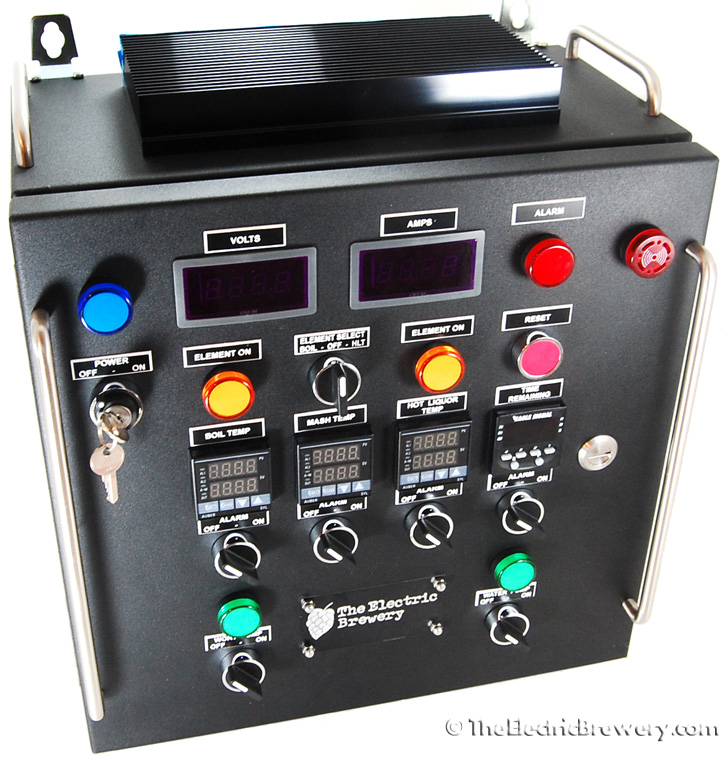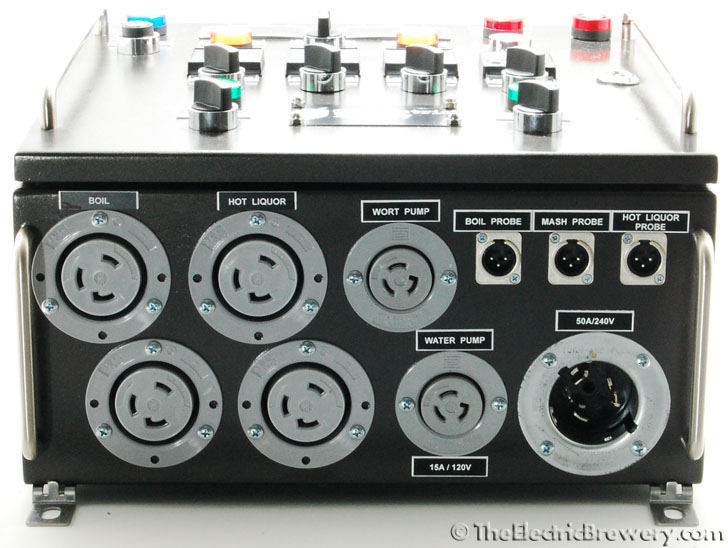Thank you so much for all of the useful information, LoL!
Now you've got your contactors, which basically do the same thing that SSR's do, except that they are mechanical relays, and they make a nice satisfying clacking noise every time that the "go ahead" signal is passed to them. They're good for taking low-amperage flows from switches and turning them into high amperage flows of electricity. Again, if you had switches on your system that could handle 30 amps of power flowing through them then you wouldn't need contactors, but those switches are pretty pricey and so it's cheaper just to go with contactors controlling the high-amperage flow of power. Since contactors aren't designed to be turned on and off very much, they don't need to have heat sinks connected to them like SSR's do, so that's one advantage to using a contactor.
And, I've now come to realize that if you want to use a switch rated for 10ish amps or less (which most of the non-toggle,metal style ones seem to be) you have to have them switch a contactor, which then opens the gates for the SSR to send the voltage in response to the PID.
If you're running new power lines to a place in your basement or garage, then I'd highly recommend just running 50 amp wiring instead of 30 amp wiring. It's not a big price differential and if you decide you need the extra power later on, it will save you money from having to rip out the old wiring and adding in larger gauge wiring.
I think that is an excellent point. I'm just going to go with 50A all the way up the receptacle that I'll plug the panel into. That makes the most sense for sure. Plus, I can later install a wind tunnel or small amusement park in my basement if I get tired of brewing!
Using one PID for two different temperature probes can be a problem. PIDs need to go through a learning program to understand how fast or slow your system heats up.
Can you even use one PID for two probes without unplugging the probe and plugging in a new one? I don't want to do that. In fact, after thinking about this more, I'm pretty sure I want 2 PIDS, maybe 3.
Yes, you can avoid all of that by just not having a temp probe inside the BK at all and just run the BK heat process in manual mode and run the BK's SSR at 100% until you get to boiling and then drop it down a bit to avoid too vigorous a boil. My system wouldn't work with that since I heat my strike water up in my BK. But to each their own process.
I had been stuck in the mindset of what Kal's 30A panel is doing. I think the extra flexibility of a 50A seems to make a lot of sense. It would be a pain to redo it all later or make a new panel again. At first, I thought I'd just throw together a smaller, cheaper one element, 1 pid panel, but maybe I'll go for the gusto a bit.
Another good reason to have the strike and sparge water separated and heating up separately: mineral additions.
You can do this if you just heat your mash water with the HERMS coil. The HLT should be able to get up to sparge temps by the time the mash is done I would hope! But, you can heat it all up faster with 2 elements at once I guess. I was interested in using the HLT to heat up some cleaning water or sanitize silicone tubing, etc. Otherwise, I'd have to install a little cooktop in my basement, which I may still do.
There's two schools of thought on the e-stop wiring. 1) You can hook up the e-stop button to force the GFCI circuit to trip, killing all power to the system. 2) You can hook up the e-stop button to a contactor that allows power to flow to the rest of the control panel, so if you hit that e-stop button, the contactor will kill all power to the rest of the control panel, but there will still be electricity flowing to that one contactor, so the panel isn't 100% "dead."
I went with the second route. I wasn't crazy about forcing the GFCI to trip like that, but I did want to make sure that if I needed power to stop flowing to the heating elements/SSRs/other contactors/PIDs/pumps/all switches except for the e-stop switch, I'd be covered.
I like the second design better too. I don't even know if I'll put an E-Stop though. Why not just use the main panel power button if you have one? I guess the E-Stop is a backup to that? you can always pull the plug too, which could take a bit more time of course.
The alarm thing is a good idea, sure, but in my own practice it's not very helpful. I set my BK PID to the proper temperature for my strike water, I set my HLT PID for the proper temp for my sparge water, and then I got and grind up my grains. If I'm away from the control panel when either of them get to the right temp, it's no big deal since the PIDs just bring the waters up to the proper temp and keep them there. Having an alarm tell you when you're getting close to boiling is a good idea, I suppose.
This seems like it would be a really nice feature. In fact, I think this is a big inspiration for me to use 2 pids, just so I can have the alarm beep in the BK when it is getting close to 208. I hate having to keep looking at the brew kettle to make sure its not boiling over now. It's a sticky mess to clean up too! I think it will be well worth it.
Those rectangular things on my control panel are digital temp displays for my MLT and chiller. They're connected to temp probes on the MLT valve output and chiller valve output, respectively. I got them off of eBay for I think $17 each, shipped. Cheaper then dedicating a $35 PID just to monitor the temps and do nothing else. The displays are much larger than a PID display too, so they're easy to see when I'm chilling the wort and I'm away from the control panel.
That is a really good idea. For chilling, you don't have to bend down and look at your panel-mounted CFC/plate, which would be good. I am on the fence about the mash. If it came with an alarm feature, that would be cool, as I could then set it to alert me when my mash is up to mashout temp or other temps. If I can't use an alarm feature on that type of monitor, it might just be worth getting another pid. It's overkill for sure, but I like not having to babysit things like that. it's low on my priority list though. the bigger display is good for sure.
My float valves are stainless steel and they're mounted about a gallon above the level of my heating elements. Sometimes I forget to turn off the power to the HLT element while sparging, and I also occasionally forget to turn off the power to the BK element while draining into the chiller. For forgetful people like me, I highly recommend them.
I was wondering if I would even leave the HLT element on when sparging. My concern is that the water recirculation will be effectively off during sparging, as the water pump will be pushing water out to the mashtun, and the wort pump will be pushing wort to the BK, so the HLT is just heating without mixing. I was concerned that maybe the temp of the actual water sparging the MT at that moment could get too hot somehow without mixing. Much more important is your point about leaving the element in the HLT on. I think I would either write it into my procedure to shut off the HLT on a timer or right when starting sparging, OR get a float valve like you have. I am assuming that on button for your HLT element has to derive its power through a float valve circuit, and if the float drops, it opens that circuit to shut off the HLT element even when the HLT power button is on. How much was the float valve? Does it fit with a weldless fitting?
Again, thanks so much for taking the time to respond with so much info.






















![Craft A Brew - Safale S-04 Dry Yeast - Fermentis - English Ale Dry Yeast - For English and American Ales and Hard Apple Ciders - Ingredients for Home Brewing - Beer Making Supplies - [1 Pack]](https://m.media-amazon.com/images/I/41fVGNh6JfL._SL500_.jpg)




























